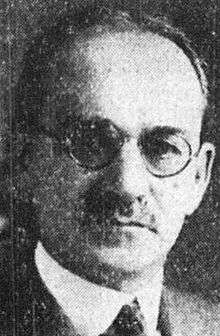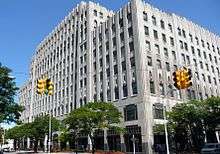Julius Kahn (inventor)
| Julius Kahn | |
|---|---|
 | |
| Born |
March 8, 1874 Münstereifel, Germany |
| Died |
November 4, 1942 (aged 68) Cleveland, Ohio, U.S. |
| Nationality | American |
| Education | University of Michigan |
| Occupation | engineer |
| Known for | reinforced concrete |
| Spouse(s) | Margaret Kohut |
| Children | Gisela, Katherine, Julius Jr. |
| Relatives | Albert Kahn, brother |
| Signature | |
|
| |

Julius Kahn (March 8, 1874 – November 4, 1942) was an engineer, industrialist, and manufacturer. He was the inventor of the Kahn System, a reinforced concrete engineering technique for building construction.[1] The Kahn System that he patented in 1903 was used worldwide for housing, factories, office and industrial buildings. His system was used in 134 US cities by 1939. His engineering system for building construction was also found then in Africa, Europe, Canada, China, Brazil, and Mexico. In Yokohama, Japan, his system was used in an automobile factory. His unique engineering system of construction was used also in airplane plants, warehouses, docks, foundries, creameries, filtration plants, rubber factories, steel plants, silos, distilleries, smelters, and textile mills.[2]
Early life
Kahn was born in Münstereifel, Germany, March 8, 1874. He was raised in Detroit, Michigan.[3] Kahn came to Detroit in 1881 from Germany with his family (five brothers and two sisters) when he was six years old, settling first in Baltimore, Maryland in 1880.[4] His father Joseph (1860–1924) was a rabbi and ran a restaurant.[5] Kahn helped in his father's restaurant business and sold newspapers.[4] His mother Rosalie was skilled in music and art.[6] Kahn went to the Detroit Public Schools where he received his elementary schooling, doing the normal four-year high school in three years.[7]
Mid life
Kahn received his higher education at the University of Michigan, which his older brother Albert helped finance.[7][8] He received a Bachelor of Science and a degree of Civil Engineer in 1896.[4] Upon graduating from U of M he did drafting work for the Union Bridge Company of New York.[4][9] Another career position was with the United States Navy as an engineer. Another engineering position he had was with the United States Army Corps of Engineers. He also worked for C. W. Hunt Company of New York. In 1900 Kahn took a position in Japan in the engineering, construction and maintenance of iron and sulfur mines.[4][7][10]

Kahn moved back to Detroit in 1902 and joined Albert Kahn Associates, an architectural firm that his brother Albert had founded in 1895.[4][7][11][12] Kahn's first assignment was in Ann Arbor.[12] He worked on the new School of Engineering building at the University of Michigan in 1903 with key architect Ernest Wilby.[13][14] He was to do tests and determine if certain materials were sufficiently strong to support the new building they were about to construct.[12] In particular they wanted to use reinforced concrete for the building floor. Kahn had already worked with reinforced concrete with the U.S. Army Corps of Engineers.[15] While he was working at the war college building in Washington, D.C., he thought of methods to improve the existing technology of old school reinforcement concrete.[7] These new ideas were the basis of the steel company he founded later.[4]
Kahn saw the structural problems inherit in the experimental method of cement reinforcement used at the end of the nineteenth century. The main problem was slippage of the steel within the hardened concrete, which weakened the building. He experimented in his brother's house basement and developed a new type reinforced beam called "the Kahn Bar", where the straight steel beam was bent back some on the edges, making stress distribution "wings" to increase tension strength.[7] He patented his invention in 1903.[16] Kahn then formed his own company called Trussed Concrete Steel Company. He became its president, but spent much of his time in the designing room.[4][17] The headquarters of the company was in Detroit, Michigan and the factory was in Youngstown, Ohio.[15] Kahn decided on Youngstown as an ideal factory location because then they could use steel that was produced in the local area, cutting down on shipping costs.[4][7]
Inventions
Kahn had at least 75 patented inventions related to reinforced concrete.[18] Kahn's first patented invention was the "Kahn Trussed Bar", also called "The Kahn Bar" or "Kahn Bar System",[19] patented in 1903.[20] This was the main product of the Trussed Concrete Steel Company, although the company produced many prefabricated steel products as well as complete buildings.[21] Kahn's co-workers noted that he would stop what he was doing and write down an idea immediately, no matter what he was engaged in.[18] Truscon employees were encouraged to come up with improvement ideas that would benefit the company and would be rewarded financially if their ideas were used.[18] For example, David H. Morgan, a company employee, invented a new type of airplane hangar door that was subsequently manufactured by Truscon and was financially rewarded for his idea.[18]
Societies and positions
Kahn belonged to the American Society of Civil Engineers. The society awarded him The Collingwood Prize for a paper he wrote in 1899 entitled "The Coal Hoists of the Calumet and Hecla Mining Company."[22] He was the founder of United Steel Company in Wooster, Ohio, and chairman of Truscon Laboratories in Detroit.[23] Kahn was a director for Mahoning Bank and the First National and Dollar Bank. He was elected a chairman of the Youngstown Chamber of Commerce grade elimination committee in 1927 and elected a director of the street car committee in 1928. He was the president of a realty firm in Detroit that was named after him. Kahn was an honorary chairman of the Allied Jewish financial campaign in 1930. He was also a member of several committees in metal-related industries. Kahn was a member of the proxy committee that opposed the deal of the merger of Youngstown Sheet & Tube Company with Bethlehem Steel.[4]
Family

Kahn married Margaret K. Kohut, daughter of rabbi Alexander Kohut, on December 23, 1903. Margaret was born in Hungary in 1876. Kahn had three children: Gisela (1906–2000), Katherine Kay (1909–1954), and Julius Kahn Jr. (1912–2009). The children were all born in Detroit, Michigan. Julius Jr. studied medicine at Ohio State University.[7]
Later life and death
Kahn was president of Truscon from its inception in 1905 until it was taken over by Republic Steel Corporation in 1935.[9] He then became a vice president for Republic until 1939.[4] Kahn retired "to private life" in 1939, but in 1940 he came out of retirement and became an executive of another steel fabricating company.[4] Kahn died 4 November 1942 in Cleveland, Ohio, of pneumonia.[9][4]
Works
Kahn wrote several engineering articles and some articles on the steel business. One article titled "Confidence and cooperation" talked about the ills of industry.[4]
See also
References
- ↑ Sedlar, Frank (April 23, 2013). "Engineering Industrial Architecture: Albert Kahn and the Trussed Concrete Steel Company" (PDF). University of Michigan Library.
- ↑ Nelson 1939, pp. 22–23.
- ↑ Shor, George G., Jr.; Shor, Elizabeth N.; Spiess, Fred N. (October 1979). "The Engineer". The George H. Scripps Memorial Marine Biological Laboratory of the Scripps Institution of Oceanography, University of California, San Diego (Report). University of California. Retrieved July 15, 2014.
- 1 2 3 4 5 6 7 8 9 10 11 12 13 14 "Julius Kahn Dies at Home". Youngstown Vindicator. November 5, 1942. p. 1, column 3.
- ↑ Matuz 2002, p. 15.
- ↑ Matuz 2002, p. 16.
- 1 2 3 4 5 6 7 8 Orr, Jack (January 1, 1933). "Julius Kahn". Youngstown Telegram. p. 7.
- ↑ Bucci 2002, p. 31; Matuz 2002, p. 35.
- 1 2 3 Derby, George (1947). "Kahn, Julius". The National cyclopædia of American biography. 33. J. T. White & company. p. 36. Retrieved July 30, 2014.
- ↑ Matuz 2002, p. 45.
- ↑ Matuz 2002, p. 45; Ferry 1987, p. 10.
- 1 2 3 Matuz 2002, p. 46.
- ↑ Bucci 2002, p. 151.
- ↑ Quivik, Fredric (2002). Rosie the Riveter National Historic Park, Ford Assembly Plant HAER No. CA-326-H (PDF). Historic American Engineering Record (Report). National Park Service, U.S. Department of the Interior. pp. 25, 26. Archived from the original (PDF) on August 10, 2014. Retrieved July 30, 2014.
- 1 2 Matuz 2002, p. 47.
- ↑ Kahn, Julius (1903-08-18). "Concrete and metal construction / Patent US 736602 A". Google Patents. US Patent Office. Retrieved July 8, 2014.
- ↑ Ferry 1987, p. 11.
- 1 2 3 4 "Kahn given 75th patent". Youngstown Telegram. February 23, 1934. p. 1, column 7.
- ↑ "Albert Kahn". Michigan Modern. Michigan State Historic Preservation Office. 2014. Retrieved July 30, 2014.
- ↑ Cody 2005, p. 37.
- ↑ Cody 2005, p. 38.
- ↑ Bucci 2002, p. 31; Municipal 1901, p. 104.
- ↑ "Julius Kahn, 68, Steel Ex-official". New York Times. November 6, 1942. p. 23, column 6.
Bibliography
- Bucci, Federico (2002). Albert Kahn: Architect of Ford. Princeton Architectural Press. ISBN 978-1-56898-343-1.
- Cody, Jeffrey W. (2005). Exporting American Architecture 1870–2000. Routledge. ISBN 978-1-135-80487-9.
- Ferry, W. Hawkins (1987) [1970]. The Legacy of Albert Kahn (reprint ed.). Wayne State University Press. ISBN 0-8143-1889-4.
- Matuz, Roger (2002). Albert Kahn: Builder of Detroit. Wayne State University Press. ISBN 0-8143-2957-8.
- Municipal Engineering. 20. Municipal Engineering Company. 1901. ISSN 0097-4129. LCCN sn82003917.
- Nelson, George (1939). Industrial architecture of Albert Kahn, Inc. Architectural Book Publishing Company. LCCN 39005868.
External links
- Michigan Historical Collections, Bentley Historical Library, University of Michigan, Albert Kahn Papers, 1896–2011
- Video on "Engineering Industrial Architecture: Albert Kahn and the Trussed Concrete Steel Company"
-
 Media related to Julius Kahn at Wikimedia Commons
Media related to Julius Kahn at Wikimedia Commons
